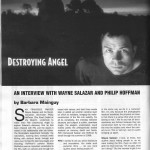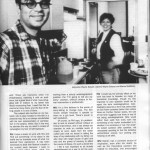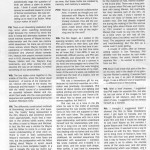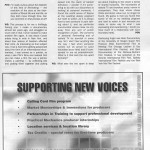by Barbara Mainguy, Point of View
Category Archives: Destroying Angel
Proposal for Destroying Angel
(16mm/B&W & Color/30 minutes)
by Philip Hoffman in collaboration with Wayne Salazar
August 1995
BACKGROUND
In 1994 I collaborated with Finnish filmmaker Sami van Ingen to produce Sweep (1995/32min). The film chronicles a journey to James Bay, in search of the place that Sami’s great-grandfather, Robert Flaherty, had been and to Kapuskasing, where my mother’s family first settled when they arrived in Canada from Poland. The film represents my continued interest in the ephemeral nature of conscious memory. It furthers my understanding of how preferred, abstract views of history are a deterrent to realising history as it is manifested in one’s identity and the activities of daily living.
In Sweep, rather than approaching these concerns alone as I had in the past, I chose to work collaboratively with an artist who was grappling with similar issues. The intersection of public and private histories was starkly visible through the figure of Sami’s great-grandfather. Robert Flaherty had made a significant contribution to the public history of ethnographic filmmaking and had left a remarkable family legacy of the great ‘genius’ artist by embodying this myth and by repeated intergenerational stories of his valour.
Our reflections were informed by a shared commitment to view the Western European colonization of Indigenous people and their cultures in light of our respective histories. We started by attempting to dismantle the division between public and private history vis a vis Sami’s great-grandfather. Formally, the film manipulates the conventions of the decidedly male ‘Road Movie’ genre which informed my earlier film The Road Ended At the Beach (1983/33 min). As expected, we immediately confronted the dilemma of how to shoot in an others’ culture, a dilemma which is the focus of my earlier filmSomewhere Between Jalostotitlan and Encarnacion (1984/6 min). The collaborative nature of this project created new possibilities for reformulating old questions about representation. Keeping in mind Flaherty’s dubious legacy of filming the ‘other’, how were we to shoot, what were we to film? These crucial questions changed through the process of collaboration from “How do we film in this Native culture?” to “What does the way we shoot tell us about the privilege we are seeking to disavow?” We filmed with this question in the forefront of our thoughts with a view to examine how the nature of our looking was always already coded as entitled by virtue of our recognisable status as privileged citizens. Thus the subject made object of the film is not others who we encounter on our privileged passage into lands of otherness, but ourselves in relation to the looking which we have been entitled to do. As the process evolved and the questions became clearer, so to was there an alteration in the way we deployed conventions borrowed from the ‘Road Movie’ tradition. The film concludes with an awareness of how the public world lives in us, despite our best intentions to live beyond the grasp of its constraints. The fantasy of mastery of living beyond this realm means not being responsible for how we inevitably can’t and don’t.
Wayne Salazar, co-maker of the proposed project, Destroying Angel, has, in past works, explored the tension between history and memory, between fact and fiction. In “Some Lies”, the essay that follows, he tells faithfully remembered stories from different stages of his life linking them together through the common themes of lies we live by and the construction of gendered identity. These stories culminate in a fictionalized present, (the beer with Leandro) an imagined scene used as a vehicle to conclude the telling of events remembered. Wayne’s concern with the construction of gender relates to my exploration of masculine subjectivity.
In Cuba/USA (1991/19 min), Wayne explores different notions of freedom through the life stories of three Cuban painters living in NYC. He focuses on how these artists’ memories of their lives in Cuba have deeply affected the form and content of their art. Each artist tells a history of events (i.e. Castro’s ascension to power) in relation to the lived histories of these artists. Through their stories and their work the divisions between proper history and personal memory are shown to be invested divisions which in fact, in real material conditions of lives lived, simply do not exist. Clearly there is a relationship between history and practice which the startling images of their art beautifully declare. Just as the stories of these artists cut across divisions between private and public vis a vis the recent history of Cuba, Wayne’s HIV seropositivity status is the point of contact between a public ostensibly objective history of AIDS and his lived ostensibly subjective experience of the disease itself.
As a visual artist Wayne has recently treated his relationship to his parents and his HIV seropositivity. He has painted self-portraits that highlight his body and the limitations his disease has put upon it, abstracted pop art images of the drugs he takes, and images of his present self with his parents. Moving these images and his project from the canvas to the screen will allow Wayne to continue this exploration using narrative as a means to get at things he wasn’t able to in two dimensions.
Waynes ability as an artist and his appreciation of process in the act of creation is complemented by his experience as a programmer at the Hawaii International Film Festival. There he created a very well-attended experimental film section of the Festival and wrote the accompanying program notes.
CURRENT PROJECT
Destroying Angel has evolved through an artistic practice which is integrally connected to my everyday life. The co-director, Wayne Salazar and I met in Sydney in 1991 where we were both attending the Sydney International Film Festival. Wayne was moved by my work to think more deeply about what he learned about family relations and how that history lives in him, disguised by popular notions about agency, free will and choice. I was moved by Wayne’s openness and his ability to speak his process out loud with a unique combination of vulnerability and strength.
Growing up in North America, we had both been differently shaped in relation to dominant and preferred modes of being masculine which, amongst other things, limit the ways in which men can relate to themselves and to others. Wayne’s capacity to resist those dominant modes, made real through the ways he interacted with me was instructive and contributed to my capacity to move onto work collaboratively with Gerry Shikatani in Opening Series – 3 (8 min/1994) and Sami van Ingen in Sweep. I met Wayne at a time when my work was turning more towards collaboration and it seems in retrospect, that our chance meeting was perfectly timed.
Wayne came to visit for the first time in May 1995 following a trip to Upstate New York to visit his mother. The time spent with his mother was troubled and Wayne used this experience as a catalyst for self reflection and revisioning about identity, love and death. In this state of mind Wayne began to notice similarities between the landscape of his childhood and the Southern Ontario landscape in which he presently found himself: there were instances of his past that were visiting him in his present in startling ways.
Building on what we had already created through exchanges over time, beginning with my desire to learn from Wayne’s ability to be fearless about how he felt, and Wayne’s interest in my past work on family and identity, we started shooting a film together. What you see in the support material are shots that Wayne took, a few I took. The images which he shot during his visit play on the tension between scenes from his history and his present day life. For example shots of rural landscapes, traveling in a car and a dog running interact with a long shot of the drugs which he takes as part of the daily effort to keep well in light of his HIV seropositivity. Upon viewing this last shot, Wayne recalled his mother’s attempted suicide by overdose of prescribed medication and the subsequent care-taking she needed which fell upon him to provide. He remembered the tension between her growing dependency on him and his struggle as an adolescent for independence, for a sense of himself outside of the roles of child turned caretaker.
I have attempted to describe the process-driven nature of this project. As such, we can’t predict how the images mentioned above, or any subsequent images will be used. However, since we are both curious about the inevitable role of storytelling in representations of both memory and history we have an idea about how we might formally explore this role. Two sequences from Destroying Angel will be re-enactments of childhood memories – both stories pertain to our relationships with our respective fathers and memories of our respective pasts (see Story Excerpts which follow). Our intention is to use a voice-over narrator to tell stories we tell ourselves about the past, rehearsed histories which restrain the excess of emotion connected with memories of those events, an excess which we are taught to believe the present is too fragile to handle.
Memory will be viewed from a variety of perspectives: memory as fiction, as history made flesh in the present moment through our desire. The challenge will be to deal with memory via the manner in which it produces emotional responses which confusingly appear like phantom pain, and which are disproportionately strong in relationship to the current situation. Such a phenomenon is connected to an event long forgotten consciously, but visible in the lingering pains confusingly present in response to events which remind us of what we are afraid to remember. For example, in the story Rabbit, I lingered on a recent incident involving the accidental death of a rabbit only to recall a hunting expedition with my father when I was young where he unwittingly wounded a rabbit who then suffered a painful death. The tyranny of memory made it difficult to recall that painful episode and thus to grasp why a similar incident in the present was so intense without any particular referent. It was only upon reflection that I was able to recognise my reaction as a response to an event long ago forgotten. It is our intention through the process of making this film together, to create an ever-changing satisfying present through recreation/reintegration of the past. In doing so the revenge of the repressed will be seen as a liberatory moment of self discovery made possible through collective reflection, not to be viewed as pathology nor solely the jurisdiction of the analyst couch, but rather an activity that belongs firmly in the social world which produces the repression in the first instance.
The stories will be told through words and images – words will give content of the memory, images will show a re-enactment of the stories, though the scenes will not be scripted. Place and elements of the original story will be brought together and integrated through the present moment. For example Wayne’s father was a traveling insurance salesman. While shooting images taken from the car during his visit with me, Wayne dislodged memories of having traveled as a child with his father while he worked his way across the U.S. selling insurance door to door. This memory became an important avenue to recalling other times of intimacy with his father and his recollection of how he had learned about love. Ingredients of the memories will blend with unpredictable and spontaneous present moments. Symbols from the memories will interplay with present moments and bring forward the way the mind/camera shapes this interplay into something new. This will stand as metaphor for making memory anew, for making a new living present passing moment. The process of making the film will be used as a vehicle for transformation of the memory maker into a living moving changing present and sitting comfortably with that present – allowing it to grow and transform, rather than solidify as ‘The Past’. The process will always take into account the making as part of the story, and integrate the process of the making with the process of memory.
We will start with three of the stories enclosed (Story Excerpts – Rabbit, Dog, Traveling Salesman). As the project grows and transforms, we will incorporate other stories you will read here. In addition stories of the past will surface and be integrated (through editing) with stories already told. This transformative process will create one new fluid narrative about relationships: son to father, father to
son, friend to friend.
By relying on this process to date we have been able to put shape to a project that could not have otherwise been conceived. Hence our faith that by continuing to trust the process, the film will figuratively make itself.
LOGISTICS OF COLLABORATION
Filming Locations:
Mt Forest Ont – Philip’s home
Ithaca NY – Wayne’s mother’s home
San Francisco – Wayne’s home
The film & sound post production will be done in
Toronto/Mount Forest by Philip with collaboration from Wayne through videotape swapping, electronic mail, and two trips for Wayne to Toronto/Mount Forest. This method was successfully used in the making of Sweep with co-maker Sami van Ingen.
Production Schedule:
August 95 to May 96
on Super-8, Hi-8 and 16mm, Wayne and Philip will shoot day to day images from home, pertaining to proposal content
November 95
Wayne to Toronto/Mount Forest/Ithaca – 2 weeks
shooting
plan and record sound
finish 1st rough cut
March 96
Philip to San Francisco – 2 weeks
additional shooting
narration recording
hi-8 edit and kine
finish 2nd rough cut
May 96
Wayne to Toronto/Mount Forest – 2 weeks
final picture and sound edit
sound mix
June 1996
1st answer print complete
REGARDING THE SUPPORT MATERIAL
In the best of all worlds, I’d like you to watch any one of my more recently completed films in order to get a sense of my filmmaking practice, including: how I handle ideas over time; explore the relationship between sound and image; and push the borders of my formal practice vis a vis experimental image making. Fantasies aside, I realise you are operating on time restraints given the number of applicants and support material you must view. In this light, I have selected excerpts from several of my films including passing through / torn formations (1988/43 min)
?O,Zoo! (The Making of a Fiction Film) (1986/23 min) and Sweep (1995/32 min)and entitled the tape Past Work Excerpts. These excerpts will focus your attention on the elements which will be further pursued in Destroying Angel i.e. storytelling/memories and collaborative production, and thus hopefully establish the link between past work and the concerns of this proposal. A second tape is included in the support material and is entitled Shooting Test – Destroying Angel. As mentioned, it includes some of the shots Wayne and I took during his recent visit to Mount Forest. I have also sent along Sweepproviding there is time to view the entire film.
STORY EXCERPTS
Wayne’s stories:
Salesman
He wasn’t home much, only on weekends, because he worked as a traveling insurance salesman. Picture this: a man with a thick Spanish accent, who had immigrated to the States from Guatemala when he was 32 years old, crisscrossing the Mid-west in his car, selling life insurance to farmers in Iowa, Illinois, Ohio, Indiana, Missouri, Wisconsin. And he was good at it.
A couple of times a year he’d take me along, and I’d help him find the little towns on the map so we could plan our route. When we got there, I’d play with the kids and with the animals. I got to see rich and poor and in-between, and to know another way of life.
Dog
I remember when I was five years old, I wondered what people meant when they used the word `love’. I knew it wasn’t something I could point at, like ‘ball’, and it wasn’t a simple action, like ‘run’. I thought about it sometimes.
That summer my dad took our dog for a walk. This was unusual but it made sense because Chico was a big dog, and whenever my brother or I took him for a walk he always ended up pulling us off our feet and running away, to be found hours later by an irate person who’s flower bed had been dug up on the other side of town. When dad came home he was carrying an empty leash.
“Did Chico run away again?” I asked
“No,” he said and then he explained that he’d gotten rid of Chico because he was too much trouble. He was given to the pound. Chico wasn’t coming home anymore.
“But I loved him!” I blurted out through my tears and suddenly I realized I new what that word meant.
I became a cat person like my mother.
Mother
My mother lives alone, in a house in the woods, with a cat named Kisa. The house is very `gray gardens’ at this point: unpainted outside for ten years, or inside for twenty. The walls and ceilings are stained from the smoke of cigarettes she chain smokes. Mold grows amongst the crumbs in the refrigerator. The bushes have grown as high as the house; the bottoms of them have been eaten away by deer in the night. She’s lonely, pining for love and human contact, but too afraid of being hurt to be able to give in the give-and-take of an emotional bond.
I hadn’t looked forward to the trip to see her. It had been three and a half years — not coincidentally, I believe, the same amount of time I’ve been living with HIV. She’s in denial; we never talk about it. She never, for instance, asks me how I feel. I want her to nurture and support me, but since I was a child it was always I who nurtured her. It was I who stood by her as she divorced my father, when her father and my brother turned against her. It was I who helped her through her attempts at suicide.
The first day of my visit to her house I was angry at her for her silence about my illness. The second day I kept reminding myself that she had never in my life been nurturing in the way I was hoping for now. I accepted that, but was still angry.
The third day, over a bottle of wine, she matter-of-factly began a conversation about the way our society keeps people in a state of prolonged childhood–keeping kids at home too long, and in school even longer–when biologically we’re programmed to leave home much earlier, at the age of 14 or so. We are meant, she said, to become independent earlier.
How then, I asked, do you account for the deep connection we continue to want with our parents, the longing we maintain for our parents’ love? Well, she said, it’s true, we all want that unconditional love. (In her case, especially, this is true: Her parents never made her feel loved. An only child, she was an accident, and always knew it.)
But I always felt loved unconditionally, I said. What I didn’t feel, and still don’t, is nurtured.
“Oh, I know,” she said, not missing a beat. “I leaned on you for far too long — I feel terrible guilty about it. I made you the parent.”
I was stunned. I didn’t know she was that aware of it.
“Yes,” I said, “that’s it exactly. So as your child, I’d like it if you could be more nurturing. And as your parent, I think you need to face my illness now, rather than later. It will only get harder for you.”
“I try not to think about it,” she said, and the waitress brought the check.
A Beginning
Today Richard said something I want to talk to him more about. I’m not sure I understand it, or can repeat it here. It has to do with the legacy people with AIDS leave to generations of survivors. He feels it benefits society, or our culture, to see PWAs conquer their demons, to find peace in their lives before they die. A legacy of peace, not struggle; of contentment, not confusion. More on this later, I guess.
Philip’s story:
Rabbit
The last time we killed a rabbit was when I was nine. Dad and I went on our winter weekend cottage trip to the lake, me running home, breathless at lunch hour Friday. Dad would pull me out of school in the afternoon sometimes so we could get an early start.
We’d go for long walks with the gun (that’s what men did), under the pretense of hunting. Mostly we walked quietly, taking in the sights of the freshly fallen snow.
The rabbit jumped out, startled us at close range, its big feet sliding across the thin cover of fresh snow, and dad knee deep, two thick legs, grounded – he reacts without thought and fires. The rabbit takes the shot, from dad’s 12 gauge. I don’t remember him ever hitting an animal except this time he did. The animal winces and scrambles to an alcove for cover. Screaming pain. We walk through some evergreen, and into the clearing to see the suffering animal – butterflies surface in my stomach; dad felt bad. The creature just stared up at us.
Twenty three years later we’re on the road to Holland Centre, in the July sunrise. After a few days of rest and work at the lake, the cottage now their home, dad is driving me to the bus for my trip back to my home, Toronto. As we leave the laneway dad slows down to let a rabbit cross our path. He says that there’s been alot of them around, and its nice to see them back again. We don’t talk much as usual, me, a bit anxious about making the bus. Dad was glad I came to help him fix the dock and haul loads of sand to the beach
for the soon to be arriving grandchildren. He liked being with his son, few words, just the bond of working together, passed down from his dad to him and him to me. I felt comfortable within this wordless intimacy.
Traveling on gravel dad turned and pointed at some beautiful wildflowers, purply branches. I ask dad to hurry. “I’ll be late..” He steps on it just as a small rabbit arrives in full view, through the clear sights of the car’s windshield. It scampers hesitantly in front and falls beneath the car’s dark, hovering body. Fur flies up behind us. The double thud tells us that the animal did not find a route through. I try and break the tension with a remark about having rabbit tonight. shit – ! Dad is silent.
As we drive I can tell it hurts him. He recalls for me other times when rabbits and dogs find their way through. Waiting for death under the car’s body – the silence could last a lifetime. And then magically across the road – safe.
Dad places the gun barrel against the rabbit’s ear to stop the pain, and fires. What’s inside comes out. The suffering stops. We trudge home through the snow…silent, defeated.
As I sit on the bus and replay the scenes to myself, I wonder where all the butterflies had gone this time…years of silence had closed tight the road from heart to speech.
I wonder whether dad went back and dragged the rabbit off the road and put it in the bushes as a makeshift burial. I imagine he might do that. Maybe I’ll call him tonight, see how he’s doing, find out what happened.



